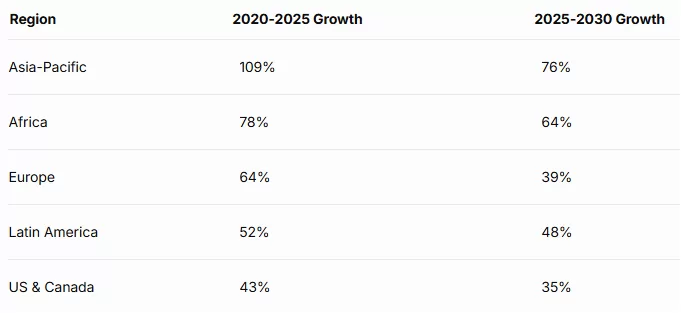Finance
Powering Resilience: How Payments Innovation Builds All-Weather Businesses

- Payments innovation plays an important role in strengthening supply chains and making them resilient and all-weather businesses through cash flow improvement, operational efficiencies, and strategic agility.
- Innovations in payment technologies have provided real examples and statistics, such as JD.com’s response to the COVID-19 pandemic, to demonstrate how these technologies foster business continuity and economic stability.
Businesses continue to experience unprecedented challenges from macroeconomic shocks, geopolitical disruptions, and swinging consumer sentiment within this dynamic economic environment. Amid this uncertainty, the idea of an “all-weather” business that can adjust and prosper irrespective of externalities is gaining prominence. An important aspect of this adaptability rests with supply chain resilience, where it must be able to withstand disruptions and ensure continuity. Such resilience lies in payment innovations, a very critical yet often unrecognised segment of functional modern business strategy.
Significance of Payments Innovation
Payment innovation advances in payment systems and payment technologies, with improvements in efficiency, safety, and flexibility in financial transactions. Payment innovations do not mean just fast or convenient transactions; they are strategic and can make a great difference in the cash management of a business against market changes or in maintaining solid supply chains.
As revealed by the report compiled by PwC, increasingly large global movements are towards cashless payments to the tune of an expected 80% rise in cashless payment volumes from 2020 to 2025, bringing the total to around 1.9 trillion transactions by 2030. This is almost three times the current figure. Consumer adoption of digital wallets, real-time payments, and other innovative payment solutions has been affecting the shift to cashless payments. However, for businesses, innovation introduces much more since it leaves cash management systems as an immediate necessity.
“In times of uncertainty, cash flow isn’t just king; it can be the entire royal court,” reads a report from PYMNTS.com. Innovative payment solutions then allow businesses to proactively manage cash flow, wherein payments become levers for competition and operational efficiencies. Faster, smarter payment systems build competitive advantage for companies within highly complex and rapidly changing supply chains as well as more unstable markets, making payments strategic assets rather than transactional needs.
Advances in Payments – The Key
One of several key innovations in payments that are important for every all-weather company and every resilient supply chain includes the following:
Embedded Finance: This is where financial services are integrated into non-financial products or platforms. A perfect example is the ‘buy now pay later’ (BNPL) option embedded within e-commerce platforms that allows businesses to extend flexible payment terms to customers, thus driving sales and managing cash flow. Such a kind of innovation is extremely pertinent for an SME that bears the brunt of financing challenges.
Virtual Cards: This is a type of digital payment card that is safe and efficient for the execution of business-to-business transactions. Virtual payment cards can be used for one-time or recurring payments with tighter monitoring of spending activities, with a reduced chance of fraud. According to PYMNTS.com, there is an increasing trend for virtual cards to be merged with mobile wallets, thereby taking B2B payments in the same direction of convenience as for consumer payment experiences.
Real-Time Treasury Software: Cash position visibility in real time across many accounts as enabled by modern treasury management systems empowers companies to better optimise their liquidity and make fast, informed financial decisions. Quoting the report by PYMNTS.com, the treasury software of Hometap, as the CFO, Tom Egan noted, does cash reconciliation across almost 100 bank accounts in hours instead of days.
Digital Wallets: The advent of new mobile payment technologies, joined with the proliferation of mobile devices, now makes digital wallets a common transactional tool for both consumers in B2C and businesses in B2B. They are easy to use and safe and have the added benefit of handling more than one currency for cross-border supply chains. According to PwC, cashless transactions over digital wallets have increased 7% globally in 2020 and are expected to cover around 50% of e-commerce transactions by 2024.
Such innovations now assist businesses in managing cash flows better, decreasing transaction times, and collecting informative data through payment settlements – essential capabilities for maintaining the supply chains’ resilience. Transaction data can eventually provide insights into customer behaviour, supplier reliability, and cash inflow trends, allowing businesses to build agility and competitiveness using advanced analytics.
Case Study: JD.com
Digital technologies, including payment methodologies, can bolster supply chain resilience. During the COVID-19 epidemic, JD.com was confronted with the dilemma of supply chain interruptions paired with mounting demand for critical items. They managed to use their fully integrated supply chain structure and digital tech, leveraging SCF as evidence in operational studies.
In this respect, JD.com specifically developed an SCF scheme aimed at providing assistance to SMEs with cash flow constraints arising as a result of raw material and labour shortages. This support helped to stabilise suppliers for increased availability of supplies, including the delivery of over 1 million medical masks in early 2020.
Thus, efficiently managing all supplier relations through logistics and financial support enhanced Jd.com’s supply chain resilience while contributing to economic stability in times of crisis. This example shows how digital advances in strategic payment management keep businesses afloat in hard times, with backend logistics and operational platforms facilitating that process.
Innovation Payment
Data from various sources indicates the importance of payment innovation; a report from PYMNTS Intelligence – cited in the article PYMNTS.com – states that only 36% of 560 surveyed small and medium businesses (SMBs) had easily available cash. It indicated that many businesses face great challenges when it comes to financing. An innovative payment solution would offer the liquidity and flexibility necessary to weather economic turbulence in such a situation.
In addition, a report by PwC indicated that 45% of respondents strongly believe that investment in mobile technology will be increased beyond retail payments related to business-to-business payments and digitalised supply chains. In addition, 42% of them were strongly orientated to pursuing advancements in cross-border, cross-currency instant and business-to-business payments, with an example of a Faster Payments Service pilot succeeding in 36 seconds of cross-border payment from Australia to the United Kingdom.
There is also a global shift towards cashless payments, which is significant; the regional growth rates from 2020 to 2025 are as follows:

This is more than 3 trillion cashless transactions across the world, and it is going to grow because of the ebbs and flows and rapid influx of e-commerce, plus real-time payments. Changing dynamics in the marketplace have proved a considerable influence on payment innovations.
Forthcoming Trends
Payment innovations will extend their growth as technologies like artificial intelligence and blockchain gradually dominate their future horizons. Some features of AI incorporate better fraud detection, advanced routing of payments, and an analytic study of probable predictions concerning cash flow. On top of everything else, the main subjects of blockchain are to promote openness and security in the majority of transactional matters concerning tough multi-party supply chains.
Through AI, predictive analysis can be directed towards foreseeing supply chain disruptions by analysing transaction data trends, while through blockchain, it could achieve secure and fully transparent cross-border payments, overcoming many of the risks associated with trade at the global level. Moreover, the study released by PwC states that 86% of respondents to the survey agree on the notion that traditional payment service providers will partner with fintechs and technology suppliers to innovate. This provides a future for partnerships in the payments business.
While this will look mainly at ESG implications in supplier selection according to PwC, it resonates with what is coming through global surveys on this. This again connects the innovative payments to the broader economic supply chain resilience as companies analyse and adopt sustainable and socially responsible practices.
In Summary,
Payment innovations have proven quite critical in building such all-weather businesses and resilient supply chains. Innovative payment models have mostly improved cash-flow management, valuable transaction data insights, and flexibility, all of which shield one from the worst effects of economic volatility. Take, for instance, the case study of JD.com during COVID-19. It shows how payment innovation keeps a company resilient in the face of crises.
In the long run, companies will be prepared to use any such innovations not all the time, but as a survival tool. These same firms will be the ones best able to navigate the path ahead through what will soon not be the same global economy. The face of global payments is changing quickly, and using these innovations now seems to be compulsory, not elective.

















































